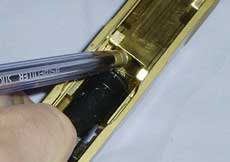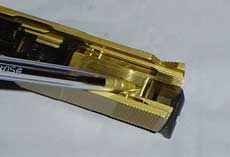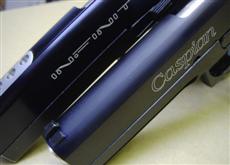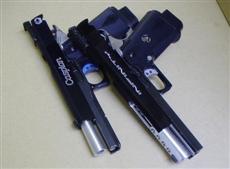
Metal Slides for the Western Arms SV Infinity Series - a fitment guide
CHOICES
PGC (Hong Kong) made Slides: As seen on WGC
and DEN-Trinity,
these come in Silver finish or Black finish (the first versions
were a sort of Tungsten colour). These along with SD, are good quality
slides, milled from Aluminium stock .
SD (Hong Kong) made Slides: As seen on DEN-Trinity, (possibly known as GRS on WGC?), these slides certainly have multiplied like the proverbial rabbits! One minute, I only knew of a few, and now there are over 15 pages of them! Fantastic I say, so much choice. Quality is as with PGC above, there appears to be less fitting of the rail grooves on the slide to the frames to be done, which is one of the hardest tasks in my opinion and some nice contrasting between Beadblasting and Satin finish grain sides.
Sheriff
(Japanese) made slides: These are of excellent external quality,
sadly they lack the INFINITY logo as standard and are sometimes
hard to find, I know because I tried for a standard replacement
for my 5", (SV-5-1B) but they (Sheriff) have sold out.
REASONS
Strength: Actually almost everything breaks, even using 134a
I have seen guns/slides break, it's just that with "Mean Green"
the process is faster. There is an old saying, "The candle
that burns twice as bright - burns half as long".("someone's
been watching BladeRunner :o)" - Arnie). If you want
power then you have to take into account the extra wear and tear
that will ensue; but to put it into perspective, I have had a gun
break in the first few mags of Green Gas, and I have had another
that has been going for 3 years with no problems!
There is of course also the additional option for the Sheriff Breech Cover to replace the plastic WA part or the newer Guarder replacements.
Weight and durability: The addition of a metal slide on your gun (WA SV's with OE heavy weight slides) will make practically no difference to the cycle speed. (Of course all this assumes the slide is fitted correctly of course.) That is because PGC and SD are almost identical in weight to the standard WA HW slides, 5 grams or so difference.

This is the WA OE heavyweight slide.

This is the SD made metal slide for the SV, notice the weight difference
between the two - the original slide is actually heavier, but by
less than 5 gms, practically nothing! (The scales go up in increments
of 5gms)
Sheriff slides are much lighter, sort of halfway to ABS weight.
To be honest, you wouldn't notice the difference between an ABS slide and a heavy weight (we're talking cyclic rate now) unless you could fire in excess of 900rpm............on semi. The recoil however, you would notice ^_-
Cosmetics: An SV with a metal slide does has that 'extra special' feeling about it, seeing that the frame, slide and barrel are metal, and there is too, that lovely change of sound when firing the gun.
Aftermarket slides normally require 'minor' fitting and now having fitted 'quite a few' ^_- PGC & SD slides to date, I can tell you the following about them:
Fitting
the metal slide: Using Needle files and 800/1000 grit wet
and dry,
N.B. SD and some PGC slides now just use the original Blowback chamber
thus negating the work involving some of the fitting with regard
to the Brass Blowback chamber. Of course this makes fitting all
the easier!
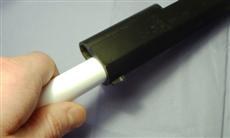 Slide
and barrel crown fit It's very rare, but on the odd occasion,
okay on 2 slides, I have noticed that the hole in the front of the
slide that the barrel protrudes through is actually too tight. Good!
this means that it can be slowly opened up to give the desired tolerance
fit required.
Slide
and barrel crown fit It's very rare, but on the odd occasion,
okay on 2 slides, I have noticed that the hole in the front of the
slide that the barrel protrudes through is actually too tight. Good!
this means that it can be slowly opened up to give the desired tolerance
fit required.
Something
round, with a diameter just under that of the hole should be wrapped
in 800 grade wet and dry, (or finer), then slowly rotated in the hole
opening it up evenly. Remember to stop frequently, clean and check
for fitment with the outer barrel as it is crucial not to go too far
and ruin this "extra" that is sadly not present of all of
the slides. The end result should be a sliding fit, but with no tight
spots. N.B.White paper used with WA slide for clarity in photo.
 Restricted
blowback units As standard, the WA guns that come with ABS slides,
have the restricted blowback unit fitted to restrict (duh!) the amount
of blowback force, as obviously a lighter slide needs less gas pressure
to propel it compared to a heavy weight slide.
Restricted
blowback units As standard, the WA guns that come with ABS slides,
have the restricted blowback unit fitted to restrict (duh!) the amount
of blowback force, as obviously a lighter slide needs less gas pressure
to propel it compared to a heavy weight slide.
e.g. I fitted a metal slide (heavier than ABS) to my F3.9. I then removed the restricting washer 138 / Rocket valve 83 / O ring 88 / Blowback inner rear unit 85 (found on the F3.9/3.9 ABS slides maybe others too) and put in replacement parts for the normal SV 5 HW slide i.e. Rocket valve 83 / Rocket valve rubber ring 86 / O ring 88 (as I did not trust the original one that jammed)/ Blowback inner rear unit 85 (this last one has a different part number to the F3.9/3.9 despite being nearly identical to look at (very slightly different size vent hole).
This action ensures that I am getting the power delivered to the blowback cycle that equals that of the OE WA HW original. That said, when replacement parts have not been available, I have on request left the blowback unit as is, with not much noticeable difference. Although when asked, "Does the gun kick more and cycle faster with the unrestricted unit?" .......I think so :-)
 Loading
Nozzle I always say, mate the slide to the frame rails by filing
the slide grooves, but here is one instance where I will "cheat"
as access is near impossible. The two wings on the loading nozzle,
as indicated by the pen tip, can sometimes be just that little bit
too snug in the slide to allow free movement.
Loading
Nozzle I always say, mate the slide to the frame rails by filing
the slide grooves, but here is one instance where I will "cheat"
as access is near impossible. The two wings on the loading nozzle,
as indicated by the pen tip, can sometimes be just that little bit
too snug in the slide to allow free movement.
The test is
that it should spring freely back into the blowback chamber when released,
(after assembly in to the slide of course, and doing this without
the blowback O-ring Part 88 will ensure that if any resistance is
being felt, it is that of the Loading nozzle). If it doesn't slide
back, or it sticks - with a very fine file or abrasive paper on a
flat surface, you just want to "kiss" the outer sides of
these two wings so that it is free to move. Approximately 0.5mm is
about the combined total that I have had to remove from both sides
on occasion. I cannot stress enough, do not go mad with your file
here, or you will run into problems.
Stronger Recoil spring In an ideal world, as a rule of thumb,
you should use the heaviest recoil spring possible, which does not
interfere with the pistol functioning.
The spring tension requirement is affected by many factors, including the gas used, grip pressure, ambient temperature, slide to frame friction, pistol type etc.
Depending on outside temperature and what gas you use, e.g. for a more potent gas, you *may* want a stronger recoil spring if you are worried about the slide battering the frame, (of course a stronger recoil spring would slam the slide forward with more force too, Newton's law of reaction!!). I have the stronger recoil springs to try, but have not fitted them as yet and from what I have seen and have tested over the years I am not sure if they ever will be needed. If the temperature in the UK was around 30'C, I may have done it by now ^_-
You see, this is the one area that my "jury" is still out on - the need for a stronger recoil spring. I have several in a parts box, and never have I even felt the need to try one on my SV's.
SightsThis can be one of the surprisingly problematic areas, in that a bodge here can prove very costly in the cosmetic stakes especially when using a black slide.
 Front
sight - dovetail Do you file the dovetail in the slide or file
the front sight (base)? To be honest, I have done both/either. Here's
why. The real SVI has a dovetail size of .300"x.060"x60'
( ' = degrees) Working in mm this is 7.5mmx1.4mmx60'
Front
sight - dovetail Do you file the dovetail in the slide or file
the front sight (base)? To be honest, I have done both/either. Here's
why. The real SVI has a dovetail size of .300"x.060"x60'
( ' = degrees) Working in mm this is 7.5mmx1.4mmx60'
The Western Arms piece uses a size of 7.3mmx1.8mmx70' according to my measurements. (Please note, this FS was taken from a 5" Railed, but WA have made different types and sizes, so check carefully).
The figures refer to width of dovetail (chisel edge to chisel edge) x height of sight base x angle of dovetail. the WA base has a much steeper cut.
It's very hard to get exact measurements, so be sure to allow some room for error. Alas it has been my experience that the WA and aftermarket slide manufacturers don't all stick to the same exact angles/dimensions (but we are talking toys after all) - one of the standardised real-steel dovetail dimensions and angles would be nice, although they are damn near close.
Getting the angles to mate is essential for a larger surface area of tight fitment thus giving a more secure fit.
It's not always
the case that the dovetail cut out on the slide is going to match
up with the WA OE front sight (which can themselves have different
size bases), or for that matter an aftermarket sight. You can do a
couple of things or combine.
File the slide dovetail slot to fit the WA sight, i.e. get yourself
some needle files, or better still dedicated dovetail cutter with
safe sides, carefully open up the slot, changing the angle if necessary,
but at the same time keeping the new angle consistent. In an ideal
world, you would just buy the correct size cutter and mount it in
a milling machine.
With a black finished slide, you don't really want to be removing that finish from any visible area of the slide, which is why in some instances it is just plain common sense to file the front sight supplied, thus if a mistake is made, at least the cost will not be prohibitive and to be honest - it can be easier! Filing the dovetail on the front sight base and the bottom of the base, may also be necessary.
I try not
to file anything that "shows" externally, so as not to compromise
the external cosmetics.
The hard part is matching the dovetail angle to the cut out, the closer
the match and the tolerance, the better the fit. . There doesn't appear
to be a hard and fast rule even when working with the same make of
slides.
Making sure the front sight stays put Once the fit is found to be satisfactory, you may also want to add something for additional security - (I always do). Western Arms themselves are now doing something additional with their current batch of slides. What this actually is turns out to be is a 3mm hole that is drilled through (from the top) in the middle of the dovetail slot. You slide the front sight in, centre it then turn the slide upside down and apply a tiny blob of superglue to the hole, being careful not to overfill it. When it set, the sight is firmly fixed in place with no externally visible signs of glue - simple :-) WA have gone a little step further and there is in fact a corresponding indentation on the underside of the current batch of front sights - this helps the superglue to key in for extra security. I have used superglue in the past, and as good as it is, like all great products it has a flaw. Shock.
Superglue by it's nature is brittle (there are rubberised cyanoacrylates) and therefore is not the best to gap fill in this instance although I have fitted many front sight without issue, for my own piece of mind, I have now switched to Loctite 270 studlock to make sure they never vibrate out, and this also gives me a much more reassuring air knowing that the sight will need plenty of force before it ever moves.
Why 270? I did use Loctite 243 (oil tolerant medium strength), to start with but, I did have an instance in CQB where my front sight was knocked free whilst in the holster or during the draw - (scuffle inside a building in complete darkness). I found said sight and vowed to go up a notch ^_-
270 - the dangers. When fitting a Heinie replacement front sight to my real SVI, I took advice and was told that this was the one to use. I was cautioned at the time to be very quick as with a curing time of under 15mins you need to get it into place damn fast. Don't take my word. Read the label. Now that was with steel, which is much harder to force the sight into the dovetail, but the trouble with Aluminium and its associated properties is that the "strength factor/cure time" changes, so although it is easier to get the front sight into position - you have less time to work with it.
The method I use is to fit the front sight to the metal slide, remove it degrease the parts to be fitted and refit with the 270 applied which during assembly will act as a lubricant. Wipe free any excess.
If you are cautious about doing it then either use the current WA method for the plastic slide or just hope that precise fitting will hold out (which it may).
After market
front sights as others have stated above can have all manner (grub
screw/roll pins) methods of additional security.
Rear sight - Bomar/Novak style Pretty much the same fitting
rules apply, although there is no need for the adhesive sealant on
the actual dovetail/slot itself as the screws/screw that holds the
blowback mechanism in place will stop any movement. Having said that
I do use Loctite 243 on these screws.
Cosmetics: Option to polish 'flatsides' if silver with very fine abrasive pad along length of slide to get "grain lines" on sides of slide.
The test of a good slide fitment is to hold the gun with the muzzle pointing into the air, pull back the slide and at various places along its travel, loosen your grip on the slide very gently and slowing its travel with your hand, and see if it sticks as it returns to battery. It should not stop.
Going too far/making an
error can ruin your gun -so take care, and go easy. Better to have
a gun that works than trying to "gild the lily". Don't forget
to relube where necessary.
Good Luck!
Matthew Dean (aka MobiusStrip)
Some examples of metal slides that I have fitted to SV's:


SCW Bulldog - Infinity based, uses SD 4.3" Black metal slide
SVI pair - 5" Railed using SD Caspian slide and SVI Hybrid using custom milled SD 5" Infinity slide

SVI Prokiller 2000 fitted with 6" barrel unit and PGC silver
slide

SVI Prokiller Mark 2 fitted with 10.5" barrel (F10) and PGC 1st
generation F3.9 Metal slide with revised brass blowback chamber



Hybrid Xcelerator - Hybrid top end and controls mounted to Xcelerator
frame. Slide is custom milled SD 5" unit.
This page last updated:
Wednesday, March 19, 2003 5:23 PM
Copyright
2003 Arnie's Airsoft

